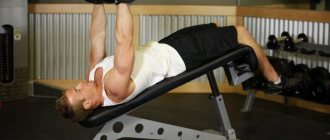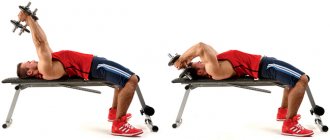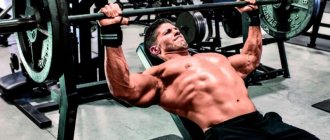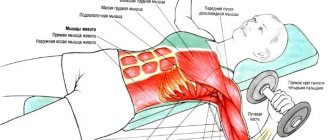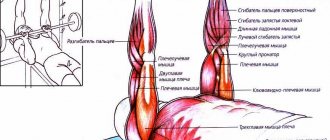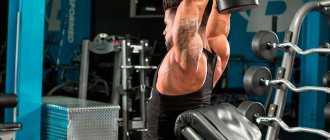Detailed technique of bench press with dumbbells video
When performing bench presses on a bench, there is a neutral grip, as well as a parallel grip.
To choose the most suitable one for yourself, we will look at each type in terms of the characteristics of execution and the muscles involved. Neutral grip - hands are turned opposite each other, elbows move closer to the body, the amplitude of the reduction at the top point is less. According to the principle of execution, this bench press resembles push-ups. With the grip in question, there is a greater emphasis on the triceps and inner chest, and less stress on the deltoids and elbows.
Parallel grip - hands with dumbbells look straight, the dumbbells seem to form one straight line, elbows are set perpendicular to the body, large range of motion. This grip increases the load on the external muscles of the chest, deltoids, and elbow joints, but reduces the load on the triceps.
To understand exactly what we are talking about, it is recommended to watch several videos of the dumbbell bench press exercise. A visual demonstration of the execution technique will allow you to better understand the main aspects of this exercise.
When training with light weights in the dumbbell bench press, a spotter is not required, since you can easily pick up, put, or, as a last resort, drop the dumbbells to the floor - this will not work with a barbell.
During the exercise, coordination and balance are trained, since the movement of the arms is absolutely free, which is not the case in the barbell press. In addition, the stretching of the pectoral muscles improves due to the ability to lower the arms lower. We must not forget about grip options, which also add more detailed work on additional muscles.
Non-professional athletes have problems with the placement of exercises in their training. Let's try to answer this question as succinctly as possible. The barbell press is a more basic, simple, accessible exercise, including for the development of muscle mass.
Barbell exercises allow you to vary the weight in almost any range and increase it slowly but constantly. In the dumbbell press, the weight is graduated in leaps and bounds, along with the weight of the equipment themselves - immediately 2 kg for each arm, or even more. This is quite difficult, considering also the balancing. To fully work out the pectoral muscles, it is recommended to perform this exercise after the barbell bench press.
Performing the dumbbell bench press exercise will not allow you to build serious muscle mass. This format of chest pumping is more complementary to the main workout than it is a full-fledged way to build pectoral muscles. The dumbbell bench press develops the strength of the pectoral and shoulder muscles, which affects the effectiveness of the entire workout as a whole and allows you to increase mass due to success in other exercises.
The mobility of this exercise is an undoubted advantage - with dumbbells it is easy to change the bench and place of training, which cannot be done when working with a barbell.
In addition, you can train with dumbbells at home - you’re unlikely to bring a barbell home, but a couple of sets of dumbbells are easy, they won’t take up much space, and are suitable for training at home for both guys and girls.
Due to the light weight (from 0.5 kg), even the most novice athlete who has decided to pick up a training object for the first time can do the dumbbell bench press. Light weight helps you hone your skills, avoid injuries, and start training at home without special equipment or tools. And buying a pair of dumbbells is not difficult, unlike a barbell with weights.
Due to the quick change of equipment, the dumbbell bench press is often used as a “control shot” in training the pectoral muscles. In this case, you don’t need to run across the entire room for other weights, remove old ones, hang up new ones, just put 2 sets of dumbbells next to you.
Muscle atlas
When performing a standing dumbbell press, athletes load not only the muscles of the upper shoulder girdle, but also the muscles of the legs and abs. Depending on the degree of load, the muscles involved in the standing dumbbell press can be divided into several main groups:
| Significant accent: | Extensor arm triceps. |
| A little emphasis: | Lateral head of the triceps. |
| Statistical load: | Wrist muscles. |
| Dynamic basis: | Upper delta. |
| Stabilizing load: | Muscles of the lumbar region. |
Load on target muscles on a 10-point scale
If we analyze the exercise from the point of view of the load on the target muscles, then the overall indicator is estimated at 22 points, which is an average number. The load on the target muscles is distributed as follows:
Light load:
- 1 point - Forearms.
- 3 points - Trapezoid.
Average load:
- 6 points - Middle deltas.
- 5 points - Triceps.
High:
- 7 points - Front deltoids.
Let's take a closer look at the technique and load on the muscle group in Denis Borisov's video:
Description of the exercise
The exercise has many variations in execution, which makes it universal for any type of training, with emphasis on different muscle groups at the request of the athlete.
. With a straight grip, the muscle stretch increases as you lower the dumbbells. A neutral grip increases the load on the muscles when straightening your arms.
Range of motion. A short press, in which the arms are not fully straightened, maintains tension in the pectoralis major muscle. The lower you lower the dumbbells, the higher the degree of stretching of the pectoralis major muscle. Do not lower the dumbbells too low, as this may cause shoulder injury. The lowest point of the movement path should be at chest level.
Trajectory of movement. You should lie flat on the bench, the dumbbells moving vertically over the middle of the chest (at nipple level). When lowering the dumbbells, flare your elbows to maximize the load on the pectoralis major muscle.
Alternating grip press. Start the exercise using an overhand grip, and as you lift, rotate the dumbbells so that your grip is neutral as you straighten your arms.
What muscles work under such a load?
When performing the exercise, the pectoral, anterior deltoids and triceps work - this is the main block of muscles involved. Auxiliary muscles are involved indirectly in the work - these are the shoulder muscles (rotators, biceps and others), the abs, gluteal muscles, and back muscles. This type of training forces you to use various muscles, tendons, and requires coordination of movements and a sense of balance.
The exercise uses many auxiliary muscles throughout the body. In addition, there are various options for execution - the bench press can be done on a positively inclined bench, negatively, on a straight bench, on the floor, on a fitball. There are a lot of equipment for performing the exercise in question, which allows you to add variety to a boring workout. Using dumbbells rather than a bar allows you to use the exercise even for beginners - the weight of the equipment is less and it is easier to train with it.
Advantages
The dumbbell bench press is less popular compared to the same exercise, but with a barbell. Even in conversation and comparison of successes, you always hear the phrase “how much do you bench press?” and the question specifically refers to the barbell bench press. The lesser popularity of the dumbbell press provides a slight advantage in the gym - you don't have to occupy a barbell rack, carry weights, or take turns with someone else on the bar, constantly adjusting the required weight on the bar.
Some athletes have physiological characteristics that do not allow them to bench press. Another pleasant bonus is the development of coordination, which will never happen in exercises with a barbell, and the additional inclusion of the shoulder girdle stabilizing muscles.
Flaws
However, there are some disadvantages to this exercise. The first is to use dumbbells of significant weight to lie down on a bench or stand with them, a rather difficult and even dangerous process. Further, a plus in terms of coordination has its opposite in the form of a minus in stretching muscles - if you overdo it with lowering the projectiles at the lowest point, overestimate the strength with weight, then stretching is guaranteed.
Read more: Table of calorie content of porridge cereals
The dumbbell press is also dangerous due to the loss of control over one of the weights, or even two at once, which leads to both damage to the equipment itself and injury to the athlete himself or others.
Recommendations
The main recommendation when performing the exercise is to first train the technique on small weights and learn to coordinate the movements of the arms, the position of the hands, the support of the legs and the position of the body on the bench. There is no need to immediately chase the weight - in the bench press, chasing records will do a disservice and lead to serious injury, because imbalance with 30 kg dumbbells has a seriously negative level of consequences.
Benefits of the Dumbbell Press
Traditionally, athletes use the barbell press. But using dumbbells has its advantages, and in some cases they will be more beneficial, especially if you combine flat and incline bench presses.
Beginners start with dumbbells
When coming to the gym for the first time, you need to understand that there is a time for everything. And you don’t need to immediately grab the barbell. Until the muscles gain strength and the technique is perfected, dumbbells are the best option. The barbell has a mass of 20 kg. This may already be too much for fragile muscles. Dumbbells will allow you to learn how to work with weights and gain strength to work with a barbell.
And even when the initial stage of the training process has been completed, and the athlete is already confidently benching the barbell, there is no point in giving up dumbbells. They will be an excellent tool for additional muscle tension after working with heavy weights.
Get the most out of your muscles
Experienced athletes are familiar with the feeling when the muscles are still ready to work, but they can no longer cope with the barbell. They won't even lift the bar. That's when they move on to dumbbells. They will help squeeze the remaining strength out of your muscles. An incline dumbbell press would be ideal as a final exercise. It will allow you to load the pectoral muscles, the anterior deltoids, and the triceps.
To “empty” the muscles as much as possible, it is enough to use light weights. You can do 2 sets of 15-20 repetitions. At first there will be an unbearable burning sensation in the muscles, then it will be replaced by a feeling of fatigue.
We work out wherever it’s convenient
Dumbbells are very convenient due to their mobility. A barbell is a stationary tool that requires not only a bench, but also a stand. You can exercise with dumbbells in the gym, at home, or on the street. It is enough to find a suitable bench (even stools placed next to each other will be suitable for this purpose at home).
Another inconvenience of the barbell is that to change weights you need to remove and install the weights. When working with dumbbells, there is no need to waste time on such manipulations. You can immediately prepare several dumbbells with different weights and place them side by side.
The gym is indispensable for dumbbell bench presses only when working on an incline. In other conditions, it will be difficult to pump the upper and lower chest.
Also, a lot depends on the training program. Which one to train on? Choose based on your training location and equipment on this page.
Hands work separately
At first glance, the barbell is good because it gives an even load on both arms. That is, they train the same way. But rarely the strength of both hands is equal. In practice, at the final stage of the exercise, you have to face a situation where one hand can no longer squeeze the weight, and the other cannot pull the barbell itself.
When performing a dumbbell press, this problem is solved by making the arms work independently of each other. If one hand can no longer cope with its weight, this does not prevent the other hand from squeezing its own.
An additional advantage is that when pressing dumbbells, balance stabilizers actively work, which is easy to lose when lifting weights separately. These muscles are activated if one of the arms lags behind and receive additional training.
The position on an inclined bench gives greater stability to the body. The load is redistributed to the heels, which serve as reliable support.
Execution technique
- Lying on a bench, take dumbbells with an overhand grip and lower them to chest level.
- Raise the dumbbells straight up, fully straightening your elbows.
- Lower the dumbbells to the starting position.
Now about the most important thing - the execution technique. In exercises with free weights, maintaining the correct technique is especially important, because the weight is not compensated for by anything and can cause significant damage to the athlete’s health. Recommended procedure when performing an exercise on a bench:
- if performed with an assistant, then the athlete first lies down on the bench so that the pelvis, body, shoulders, and head are on the bench. The body position is exactly in the center, then alternately receives both dumbbells in the arms bent at the elbows;
- if the exercise is performed independently, then we take dumbbells from the rack and sit on the bench so that they stand on the hips. Next, we round our back, pressing our chin to our chest, and carefully lie down on the bench. We hold the projectiles closer to the body in bent arms and, after taking a lying position, begin to perform them.
- legs are placed at an angle of about 50..60 degrees for stability, the foot should be completely on the floor;
- dumbbells describe a smooth arc, no sudden or jerky movements;
- at the top point, try not to push the dumbbells together;
- the lower you lower your arms, the more the pectoral muscles will stretch, but you cannot forget about safety measures;
- the arms are set away from the body at a right angle, which does not change during the training, that is, the elbows are not spread apart or brought together;
- We perform arm movements as synchronously as possible, the dumbbells are on the same line and move simultaneously and in the same plane;
- you cannot “tilt” your wrist back, doing the exercise with your hand and not with your hand - this way you can easily injure your wrist;
- There is no need to perform the exercise to failure - when you feel that one more repetition will not work, stop doing it. Exploits a la “a little more, a little more” can lead to loss of control and injury.
Main mistakes
It is necessary to perform the dumbbell bench press intelligently and sensibly, to avoid mistakes that led athletes to disastrous consequences:
- too much weight. Always adequately assess your strength; too much weight will lead to jerky movements instead of smooth progressive ones. Such jerking actions with weights negatively affect the body’s condition, leading to the dumbbells being torn from the hands, and injury due to loss of balance;
- incorrect starting position of the body. With crossed or bent legs, an uneven spine, or a tilted head, the risk of injury is extremely high;
- the elbows are not perpendicular to the body, but are located at an incomprehensible angle from it. This happens quite often, especially if an athlete practices on a bench lying down, without a coach or spotter who can help with the correct positioning of the hands;
- looking around, turning your head in different directions. Such actions, despite their harmlessness, can lead to loss of control over the hands with heavy dumbbells, loss of balance, loss of weights, and even injury to both the neck and other muscles;
- lack of knowledge of the assistant's procedures for insurance. If an athlete performs a head-down press, he takes one dumbbell on his own, and an assistant gives him the second.
When performing any bench press, there is no need to push a person’s elbows, grab hands or perform other sudden movements - the role of the assistant should be minimal and sufficient for independent performance. Urgent intervention will be required only as a last resort, if the athlete no longer has the strength to lift up and risks losing weights on the floor.
Typical beginner mistakes
Along with the bench press, deadlift and squats with a barbell on the shoulders, the military press is an exercise that can not only contribute to the all-round development of the athlete, but also cause irreparable harm to health, and recovery from the injury can take more than one month. Therefore, if you recognize yourself in one of the points described below, you should reconsider your military press technique, starting from the very basics, and even better, do not repeat your mistakes and seek help from an experienced, highly qualified instructor.
Neglecting warm-up
Before performing a classic standing barbell press, due attention should be paid to joint warm-up; shoulders, hands and elbows should be thoroughly warmed up and prepared for work. If your working weight in the military press is high enough, take the time to perform several warm-up approaches, starting with an empty bar and gradually increasing the weight of the apparatus. It is also recommended to stretch the triceps separately, since it receives a decent load in this exercise; several sets of extensions from the upper block with light weight will only be beneficial.
Too much weight
The standing barbell press is an excellent accessory exercise for the bench press, but even it is not recommended to work in a very low repetition range and with a huge weight. If you lift a weight that is too heavy, you lose almost all the benefits of doing this exercise, since you do not have time to put enough stress on the deltoids (shoulders do not like work in low rep ranges; our deltoids and shoulder joints are simply not designed for strength work). You also overload the rotator cuff and ligaments of the shoulders, elbows and hands, which can lead to injury.
In such traumatic exercises, you should never deviate from the correct technique in favor of heavier weights or more repetitions. By including additional muscle groups (legs, lower back), you not only reduce the effectiveness of the standing barbell press, since the shoulders receive less load, but you also risk serious spinal injury due to severe compression of the intervertebral discs in the lumbar region.
Fixation at the top point
You should not fixate at the top point for more than a few seconds - this will increase the axial load on the spine significantly, as in squats with a barbell overhead.
Incorrect position of the bar
The projectile should be located on the chest or in close proximity to it and the collarbones. If the barbell is brought forward too much, the shoulder joint moves a little forward, and the position of the elbow is also unstable. Doing a military press in this position, I give a 99% guarantee that you will get injured.
Choose the right shoes
Take this point seriously, remember that your legs are your foundation, and the entire result depends on how strong and stable it is. If you find it difficult to maintain balance during the approach, try changing your training shoes; it is best to use sneakers with a rigid sole without a heel or instep.
Don't experiment with overhead presses
If you have mastered the correct technique of the military press and have developed a good neuromuscular connection in it, leave this shoulder exercise as the main one in your arsenal, do not try to replace it with the barbell overhead press. The load in these two exercises is almost the same, the main part of it falls on the anterior delta, but when pressing from behind the head, the shoulder joint is fixed in an unnatural position, due to which it is often subject to injury.
Video from Alexey Nemtsov about common mistakes beginners make when performing standing barbell presses:
Flat bench press
The technique of performing on a horizontal bench is classic and is described in the section above. The description can be supplemented with the feature of returning from a lying position to a sitting position.
Read more: Raising dumbbells in front of you - a complete guide to use
When rising from a dumbbell bench press, you need to: bend your elbows, press the dumbbells towards you, lower your chin, pull your knees towards you and jerk your legs and upper body to a sitting position. Throwing a weight from your hands onto the floor to the sides is dangerous not only for your wrist, but also for those training nearby - getting hit with even three kilograms on your leg is completely unpleasant, not to mention heavy weights.
Presses at an angle of 30 or 45
When performing such an exercise on a bench at an angle of 30 or 45 degrees, not only the position of the bench and body shifts, but also the emphasis on the muscles. With a positive angle of inclination (forward), the upper muscles of the chest and shoulders are more involved.
The technique is the same as in the classic dumbbell bench press, only it is easier to take the starting position both at the beginning of the exercise and at the end. The legs will have to be placed slightly wider as the load increases due to the slope.
And there is one more nuance - since the body does not lie flat, you can start to move off the bench if the seat on it does not automatically adjust when you change the angle of the backrest. If you need to adjust the seat manually, then lift it towards you so as not to slide off the bench during the exercise.
What are the options and which is better?
The lower press can be performed in several variations:
- when using dumbbells;
- on the Smith machine;
- with a barbell.
The question arises, which of the existing bench presses is still more effective for muscles. Studies have shown that performing exercises with the head down is an opportunity to pump the pectoral muscles more effectively (when compared with the top position). But not everything is clear here. If it is necessary to “trim” the pectoral area, then the best option is the lower press, if the clavicular area is the upper one.
Another study showed that when performing the “lower exercise,” the pectoral muscles take on the maximum load. As a rule, it is twice as much weight as the pectoral muscles bear during a standard horizontal press.
But that's not all. In 2010, scientists were able to prove that the lower or upper press has the same effect on the upper pectoral muscle. So the statement that to pump up the upper pectoral muscle it is necessary to use only the “upper” press is not correct.
In addition, when bending the body, the athlete can take more weight than with a standard bench press (by about 15-20%). This is due to three different reasons:
- firstly, working at a downward angle connects more pectoral muscles, which allows you to develop much greater force;
- secondly, the body is in a special position, which shifts the emphasis from the triceps and deltoid muscles to the chest and back muscles. All this allows you to apply much more force;
- the amplitude becomes smaller than in the case of a horizontal press.
Based on the above, we can conclude that the dumbbell (barbell) press in the lower position can be called a more effective exercise.
Head press
The dumbbell bench press upside down is more difficult than the classic one and has more restrictions. The area of use is small due to the large rush of blood to the head. This exercise is not recommended for headaches and migraines, blood pressure problems, head injuries, or in old age.
This version of the exercise allows you to more thoroughly work the lower part of the pectoral muscles. It is performed with an assistant, since picking up the dumbbells yourself or putting them back in this version is difficult and inconvenient.
One arm press
A very interesting version of the exercise. He can sometimes be found in the gym. This type of training exists and is even used, but it is more suitable for professional athletes who purposefully and precisely train all parts of the body for competitions, as well as for those who, for some reason, cannot perform a regular bench press with both hands at once.
In other cases, the exercise does not provide any benefits, but it requires significant coordination, clarity of movements, knowledge of your physical level of development and capabilities. Look how harmoniously Jay Cutler, Mr. Olympia 2006-2007, 2009-2010, performs this movement.
Dumbbell press on fitball
This method of training is perfect for athletes with spinal problems, when it is difficult to perform on a hard bench. The fitball takes some of the load off the back, making it easier to perform.
Do not forget, however, that the fitball is not fixed to the floor as clearly as a bench, but has freedom of movement. Therefore, performing bench presses on a fitball increases the coordination load, as well as the load on the neck, abs, buttocks and legs to keep the whole body in balance.
Standing barbell press (military press)
The standing barbell press or military press is a basic exercise for developing the deltoid muscles and the overall mass of the shoulder girdle. This exercise puts the greatest stress on the shoulder muscles, which is necessary for their hypertrophy, since in a classic standing barbell press an experienced athlete can work with very decent weights, which will have a beneficial effect on increasing strength and gaining muscle mass. Just look at the world record of the Soviet weightlifter Vasily Alekseev - 235 kg! Today we will talk about how to do a standing barbell press correctly, what muscles work during this exercise and typical mistakes of beginners.
Previously, this exercise was included in the competitive weightlifting program, then athletes performed three movements: the snatch, the clean and jerk, and the standing barbell press. However, over time, the military press was excluded from competitive weightlifting due to its risk of injury and vague judging criteria - many athletes performed something between the military press and the barbell push press, but for some the movement “counted”, while others did not, and therefore they moved up a wave of misunderstandings and disputes, including in the political arena. However, to this day this exercise is widespread all over the world, and it can be seen in almost every gym on the planet, and people who are interested in CrossFit, fitness, martial arts or weightlifting devote a lot of time to the military press as part of their training process. In our article today, we will tell you how to do a standing barbell press correctly, and also delve into some of the nuances and subtleties associated with this exercise.
Today we will look at the following aspects of interest to us related to this exercise:
- What muscles work when doing a standing barbell press?
- Technique for performing the exercise;
- Typical beginner mistakes;
- CrossFit complexes containing military press.
Workout Features
The format of training for the chest with dumbbell press directly depends on the level of physical development of the athlete. Conventionally, all trainees can be divided into 3 categories: beginners, intermediate level and advanced. Below we list the main recommendations for each category of trainees.
Beginners
The dumbbell bench press is done at the beginning of the workout (the first or second exercise) so that you have enough strength for the remaining exercises. As a rule, the first time you train with light weight, the number of repetitions is 8-12, in 3-4 sets. This schedule allows you to avoid stress on the body and muscles, damage, and also gradually accustoms you to coordination of movement and balance.
Average level
The exercise is used as an additional exercise in the general complex. With its help, you can load various parts of the pectoral muscles, additionally work them out and “hammer” them.
What muscles are pumped with the military press?
The standing military chest press is a compound exercise for developing the entire array of muscles in the upper body. With its help, the strength and size of the triceps is built, the muscle growth of all deltoid muscle bundles increases, and the back muscles are also worked out. This is one of the main exercises for pumping up the shoulder girdle, although a huge number of auxiliary muscles are involved. The military press also targets the upper thighs, glutes, and abdominal muscles, which need to be strong to stabilize the body during the movement.

